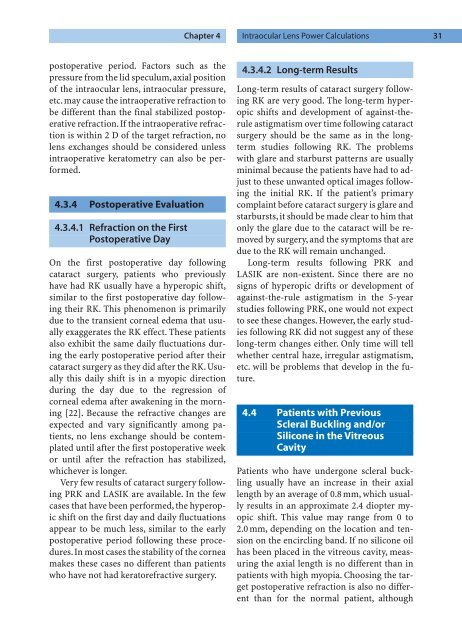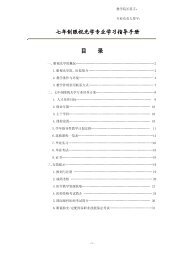Refractive Lens Surgery
Refractive Lens Surgery
Refractive Lens Surgery
You also want an ePaper? Increase the reach of your titles
YUMPU automatically turns print PDFs into web optimized ePapers that Google loves.
postoperative period. Factors such as the<br />
pressure from the lid speculum,axial position<br />
of the intraocular lens, intraocular pressure,<br />
etc. may cause the intraoperative refraction to<br />
be different than the final stabilized postoperative<br />
refraction. If the intraoperative refraction<br />
is within 2 D of the target refraction, no<br />
lens exchanges should be considered unless<br />
intraoperative keratometry can also be performed.<br />
4.3.4 Postoperative Evaluation<br />
4.3.4.1 Refraction on the First<br />
Postoperative Day<br />
On the first postoperative day following<br />
cataract surgery, patients who previously<br />
have had RK usually have a hyperopic shift,<br />
similar to the first postoperative day following<br />
their RK. This phenomenon is primarily<br />
due to the transient corneal edema that usually<br />
exaggerates the RK effect. These patients<br />
also exhibit the same daily fluctuations during<br />
the early postoperative period after their<br />
cataract surgery as they did after the RK. Usually<br />
this daily shift is in a myopic direction<br />
during the day due to the regression of<br />
corneal edema after awakening in the morning<br />
[22]. Because the refractive changes are<br />
expected and vary significantly among patients,<br />
no lens exchange should be contemplated<br />
until after the first postoperative week<br />
or until after the refraction has stabilized,<br />
whichever is longer.<br />
Very few results of cataract surgery following<br />
PRK and LASIK are available. In the few<br />
cases that have been performed, the hyperopic<br />
shift on the first day and daily fluctuations<br />
appear to be much less, similar to the early<br />
postoperative period following these procedures.In<br />
most cases the stability of the cornea<br />
makes these cases no different than patients<br />
who have not had keratorefractive surgery.<br />
Chapter 4 Intraocular <strong>Lens</strong> Power Calculations 31<br />
4.3.4.2 Long-term Results<br />
Long-term results of cataract surgery following<br />
RK are very good. The long-term hyperopic<br />
shifts and development of against-therule<br />
astigmatism over time following cataract<br />
surgery should be the same as in the longterm<br />
studies following RK. The problems<br />
with glare and starburst patterns are usually<br />
minimal because the patients have had to adjust<br />
to these unwanted optical images following<br />
the initial RK. If the patient’s primary<br />
complaint before cataract surgery is glare and<br />
starbursts, it should be made clear to him that<br />
only the glare due to the cataract will be removed<br />
by surgery, and the symptoms that are<br />
due to the RK will remain unchanged.<br />
Long-term results following PRK and<br />
LASIK are non-existent. Since there are no<br />
signs of hyperopic drifts or development of<br />
against-the-rule astigmatism in the 5-year<br />
studies following PRK, one would not expect<br />
to see these changes. However, the early studies<br />
following RK did not suggest any of these<br />
long-term changes either. Only time will tell<br />
whether central haze, irregular astigmatism,<br />
etc. will be problems that develop in the future.<br />
4.4 Patients with Previous<br />
Scleral Buckling and/or<br />
Silicone in the Vitreous<br />
Cavity<br />
Patients who have undergone scleral buckling<br />
usually have an increase in their axial<br />
length by an average of 0.8 mm, which usually<br />
results in an approximate 2.4 diopter myopic<br />
shift. This value may range from 0 to<br />
2.0 mm, depending on the location and tension<br />
on the encircling band. If no silicone oil<br />
has been placed in the vitreous cavity, measuring<br />
the axial length is no different than in<br />
patients with high myopia. Choosing the target<br />
postoperative refraction is also no different<br />
than for the normal patient, although



